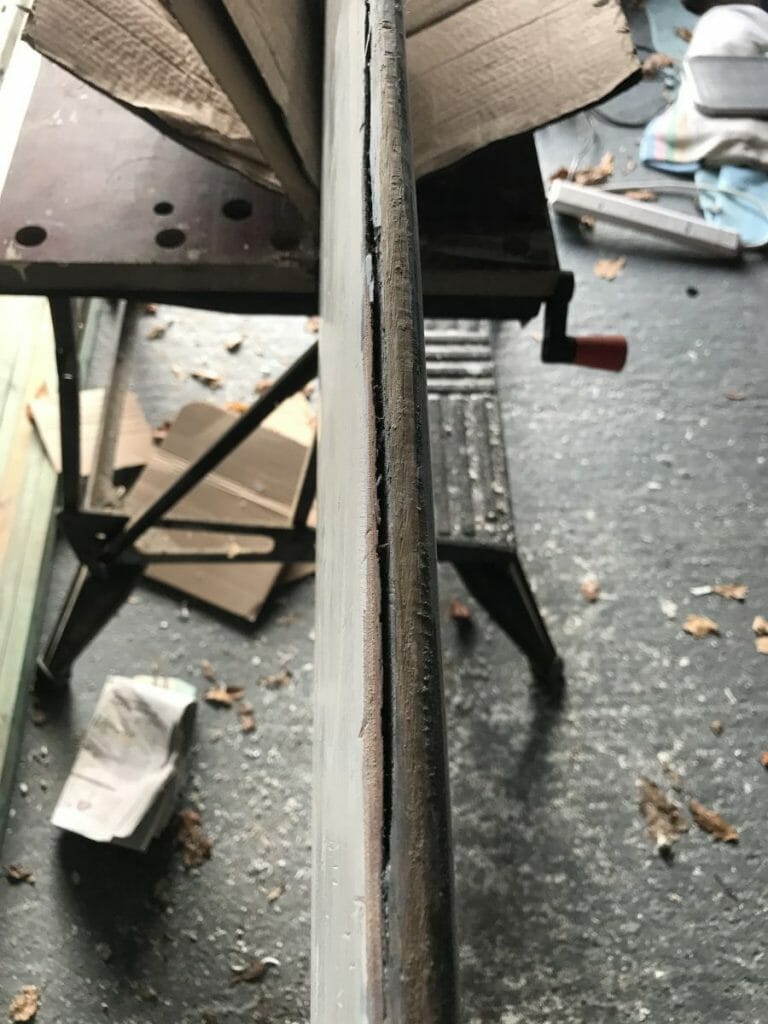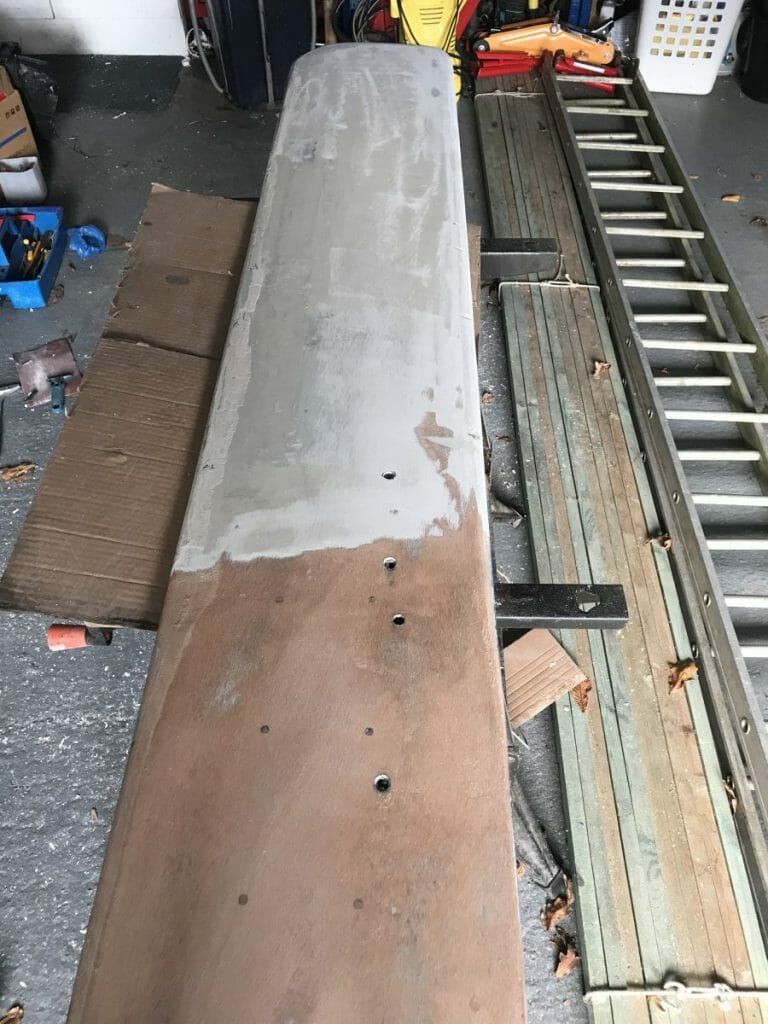Colchide came out the water last week and I noticed that the rudder had some delamination cracks on the trailing edge. It has a 12mm central oak core and a further 12mm of marine ply on each side, totalling 36 mm. To stop water ingress in the future and so I can leave it in the water all the time (at the moment I remove it from it’s stainless steel cassette at the end of every sailing day), I am thinking of sheathing it. The local glass fibre specialist says he can sheath it with 1 mm coloured mat, then resin, which will definitely stick to the wood, and it will be completely waterproof. He quoted £80.
Any thoughts please?

A89 Colchide Rudder - December 2019
A89 Colchide Rudder - December 2019
A89 Colchide Rudder - December 2019
A89 Colchide Rudder - December 2019- I confirm that I have rights to the material uploaded above and agree that the AOA may use this material on the website as defined in the website Terms and Conditions (see link in footer)




Here’s an update on Colchide’s rudder. It has been in our house for over a month, laying flat on kitchen tiles. I used a dehumidifier and reduced the main stock readings from 11% damp to 7%. In the area of the crack, readings have gone from 26% down to 7% too. The photo of the crack makes it look much worse than it actually was. I filled it in the house with cataloy filler and let it go off fully. On a 12 degree, sunny day last week, I finished off the rubbing down with 400 grit wet & dry and applied some (pre-heated) Hempel Underwater Primer, thinned 10% as directed. I am now slowly building up the 4 layers of this excellent primer, with rubbing down with 400 grit wet & dry between every coat. It now looks pretty darn good. I’ll keep you posted…………..
Richard
Accoya sounds interesting. I had not really come across it before and it does look like a handy material.
I found this video about how it is fabricated interesting. https://www.youtube.com/watch?v=_ZM2njWxgxM
It looks very expensive – has your shipwright friend experience of using it ? The other aspect for the rudder blade is resistance to bending stresses set up underway. Is it is a strong in bending as the ply/mahogany laminated rudder you have at present?
Nick
Uncle Bernard used Marglass only on the hull when he built Colchide from 1959 – 1960. The wooden blade rudder was a later modification in the 1970s. I have now completely stripped the rudder of paint and it is in my house drying off over Christmas. Initial damp readings were 11% all over and I’ll keep everyone informed if the damp readings reduce. I was chatting to a boatbuilder yesterday who suggested another way of solving this whole problem:
MAKE ANOTHER RUDDER WITH ACCOYA
Advantages of Accoya
50 yr above ground/25 yr in-ground warranty against rot
Dimensionally stable (no more swelling, twisting, bowing or warping)
Extremely hard wood, similar to mahogany Janka rating
Longer paint life (due to decreased wood movement)
Accepts stains and varnish well
Non-toxic, natural wood product
FSC certified renewable resource
Disadvantages of Accoya
Requires stainless fasteners
Prone to increased blowout during milling processes
Limited availability
Not locally sourceable
Comments please.
Richard,
I used accoya for Mourne Goblins toe rails it was easy to machine (better than sapelle) Arnold Lavers keep in stock I believe, cost didn’t seen excessive. My friend who is a professional joiner now uses it when ever he makes windows due to its stability
Dom
Thanks for your comments Mike.
I think this repair needs careful consideration!
The delamination could lead to rudder failure under load. Which would be embarrassing if not dangerous.
I would be cautious about sheathing wood with a polyester based resin. That will not adhere well to wood whatever anyone says. The only way to reliably sheath it would be with epoxy. West is my preferred epoxy system because I find it reliable and forgiving.
The real issue here isn’t the sheathing – it is actually repairing the delamination. To do that you need to work out what is delaminating. It it the joint between the ply and the wood? Is it within the plywood? If it is the interface between the ply and the wood then perhaps the layers can be prized apart and the joints remade. If it is within the ply then the ply needs replacing.
Whatever you do I would discourage just glueing the crack back together and sheathing it.
Thank you for your thoughts Trevor. I have over 4 months before Colchide is going back into the water, so there is no rush. My current thinking is to investigate further the crack and possible delamination. I am going away from the sheathing idea. Nick also suggested drying the rudder inside the house over the winter for a couple of months, then applying a liquid which will not allow further water penetration, then several coats of primer/undercoat/topcoat.
Hi Richard
Interesting! As Mike says it would be important to understand why the gaps have appeared – what is going on in the rudder.
Sheathing is something that can be excellent, or not so..
The danger is that if it is breached anywhere water and rot can build up behind the sheathing before there is any external visibility of problems.
Personally I have always avoided sheathing but carefully done, on dry wood first treated with saturating resin it can be effective. And if you adopt a varnished finish over the sheathing any issues under the sheathing will be visible…..
A useful guide by WEST on sheathing http://www.robbins.co.uk/Pdf%20Files/sheathing_guide.pdf
And Gurit’s SP version of the same https://www.boatpaint.co.uk/acatalog/datasheets/sp/Sheathing%20Guide.pdf
Given the rudders age yet apparently excellent condition after decades except for the gap on the trailing edge, why not just repair the gap and then paint for a few more decades use?
Nick
Thanks for your comments Nick.
I reckon the rudder needs attention. Has the crack penetrated deeper – splitting the layers, in which case repairs will be extensive. Noi experience of glass fibre repairs. Did Bernard use Marglass on the rudder too. Presume Marglass is compatible with glass fibre. Good luck. Mike